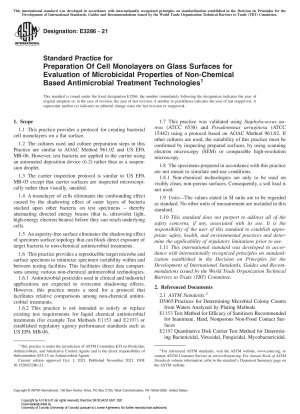ASTM E3286-21
Standard Practice for Preparation Of Cell Monolayers on Glass Surfaces for Evaluation of Microbicidal Properties of Non-Chemical Based Antimicrobial Treatment Technologies
- Standard No.
- ASTM E3286-21
- Release Date
- 2021
- Published By
- American Society for Testing and Materials (ASTM)
- Latest
- ASTM E3286-21
- Scope
- 1.1 This practice provides a protocol for creating bacterial cell monolayers on a flat surface. 1.2 The cultures used and culture preparation steps in this Practice are similar to AOAC Method 961.02 and US EPA MB-06. However, test bacteria are applied to the carrier using an automated deposition device (6.2) rather than as a suspension droplet. 1.3 The carrier inspection protocol is similar to US EPA MB-03 except that carrier surfaces are inspected microscopically rather than visually, unaided. 1.4 A monolayer of cells eliminates the confounding effect caused by the shadowing effect of outer layers of bacteria stacked upon other bacteria on test specimens – thereby attenuating directed energy beams (that is, ultraviolet light, high-energy electron beams) before they can reach underlying cells. 1.5 An asperity-free surface eliminates the shadowing effect of specimen surface topology that can block direct exposure of target bacteria to non-chemical antimicrobial treatments. 1.6 This practice provides a reproducible target microbe and surface specimen to minimize specimen variability within and between testing facilities. This facilitates direct data comparisons among various non-chemical antimicrobial technologies. 1.6.1 Antimicrobial pesticides used in clinical and industrial applications are expected to overcome shadowing effects. However, this practice meets a need for a protocol that facilitates relative comparisons among non-chemical antimicrobial treatments. 1.6.2 This practice is not intended to satisfy or replace existing test requirements for liquid chemical antimicrobial treatments (for example Test Methods E1153 and E2197) or established regulatory agency performance standards such as US EPA MB-06. 1.7 This practice was validated using Staphylococcus aureus (ATCC 6538) and Pseudomonas aeruginosa (ATCC 15442) using a protocol based on AOAC Method 961.02. If other cultures are used, the suitability of this practice must be confirmed by inspecting prepared surfaces, by using scanning electron microscopy (SEM) or comparable high-resolution microscopy. 1.8 The specimens prepared in accordance with this practice are not meant to simulate end-use conditions. 1.8.1 Non-chemical technologies are only to be used on visibly clean, non-porous surfaces. Consequently, a soil load is not used. 1.9 Units—The values stated in SI units are to be regarded as standard. No other units of measurement are included in this standard. 1.10 This standard does not purport to address all of the safety concerns, if any, associated with its use. It is the responsibility of the user of this standard to establish appropriate safety, health, and environmental practices and determine the applicability of regulatory limitations prior to use. 1.11 This international standard was developed in accordance with internationally recognized principles on standardization established in the Decision on Principles for the Development of International Standards, Guides and Recommendations issued by the World Trade Organization Technical Barriers to Trade (TBT) Committee.
ASTM E3286-21 Referenced Document
- ASTM D5465 Standard Practice for Determining Microbial Colony Counts from Waters Analyzed by Plating Methods
- ASTM E1153 Standard Test Method for Efficacy of Sanitizers Recommended for Inanimate Non-Food Contact Surfaces
- ASTM E2197 Standard Quantitative Disk Carrier Test Method for Determining Bactericidal, Virucidal, Fungicidal, Mycobactericidal, and Sporicidal Activities of Chemicals
- ASTM E2756 Standard Terminology Relating to Antimicrobial and Antiviral Agents
ASTM E3286-21 history
- 2021 ASTM E3286-21 Standard Practice for Preparation Of Cell Monolayers on Glass Surfaces for Evaluation of Microbicidal Properties of Non-Chemical Based Antimicrobial Treatment Technologies
